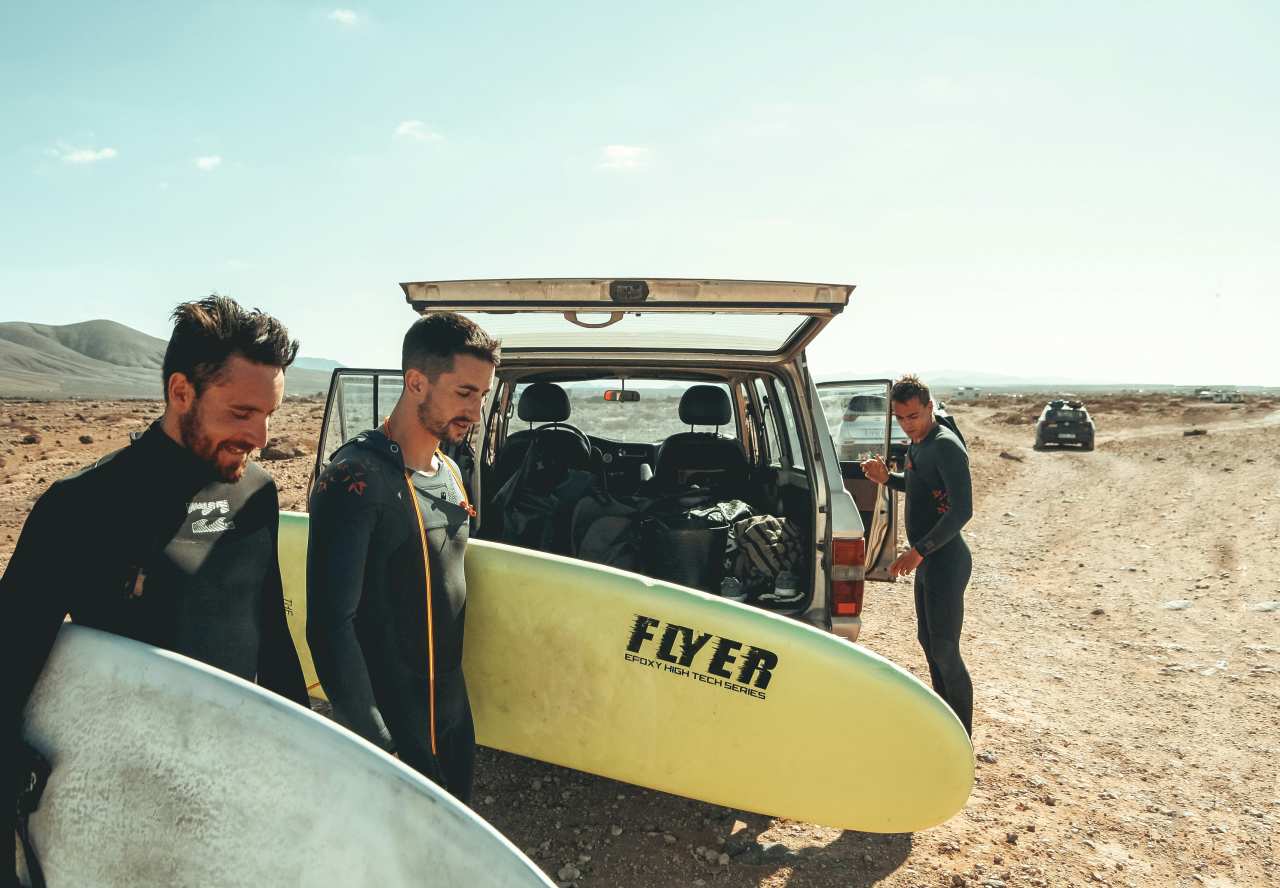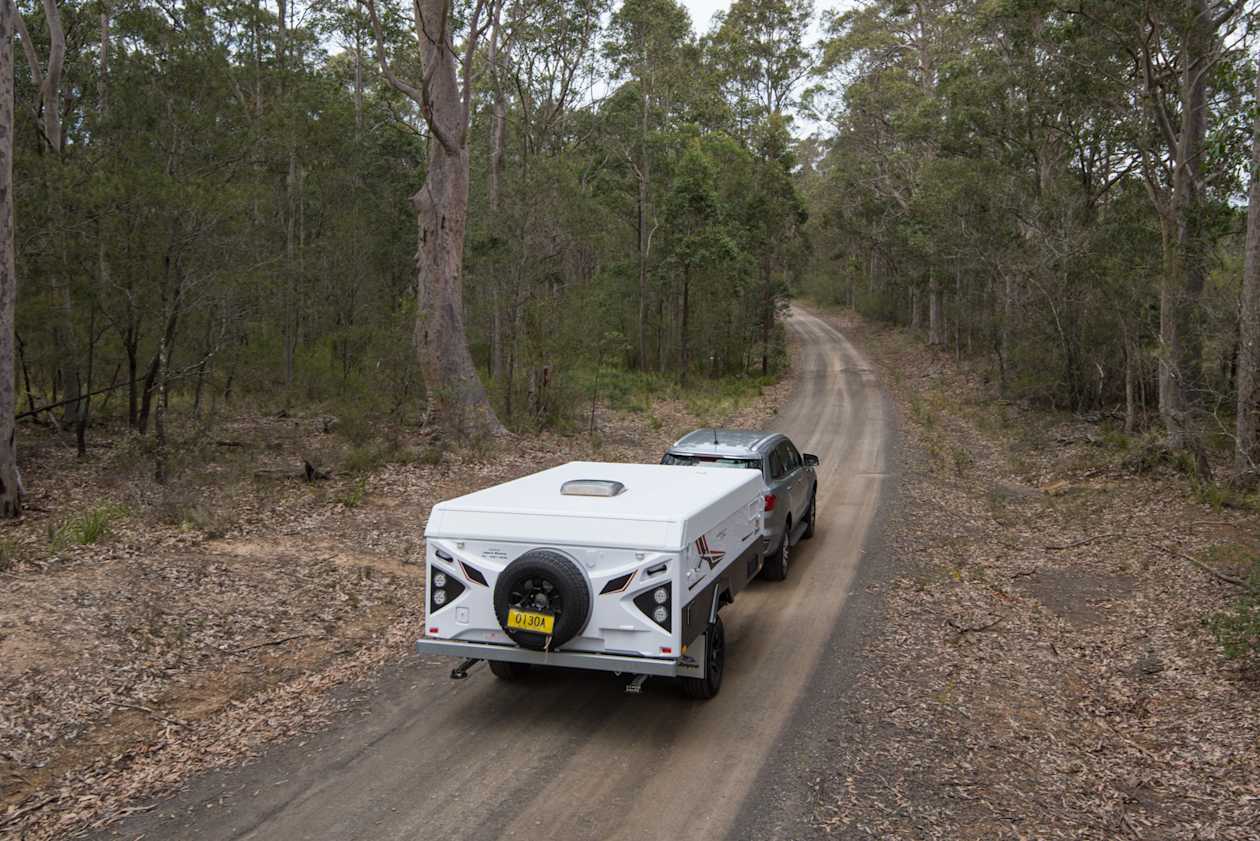In light of the large volume of dirt-road-friendly camper-trailers being seen on bush tracks of late you’d be safe in assuming that they are the flavor of the month.
Sure, lots of people buy into the idea of the off-road-camping lifestyle and may get a surprise when faced with the reality of it, but the number of those who swiftly grow to love the camper-trailer way, far out-weigh the number of those who don’t.
We took a Hawk Outback into the bush to check it out.
How big is this camper-trailer? How much does it weigh?

| Length | 5060mm |
| Width | 2240mm |
| Height | 1910mm |
| Weight (Tare/ATM/Tow Ball) | 1285kg / 1585kg / 145kg |
The Hawk Outback (from $27,990) is 5060mm long, 1910mm high and 2240mm wide. Its tare weight is 1285kg.
When this Outback is set up, its length extends to 6200mm (total) and 4040mm (in the body) and the interior is 2070mm high – so it has similar dimensions to other models in this range.
Jayco states that the Hawk Outback “sleeps four adults and two children”. It has two beds, a convertible dinette, and separate kitchen and living areas.
How easy is it to tow?

Because of its compact size – especially relative to caravans which are, by their very nature, generally bigger and bulkier than camper-trailers – the Hawk Outback is a very easy thing tow as it sits low and stable on all surfaces and well within the confines of even narrower bush tracks.
The single-axle camper – 5060mm long (including drawbar), 1910mm high, 2240mm wide, and with a 1285kg tare weight – hardly registered behind our tow vehicle, a 2019 Ford Everest, with the new 2.0-litre four-cylinder bi-turbo-diesel engine (157kW/500Nm).
It always felt secure on the towball (with a 145kg download) during highway, gravel track and undulating dirt-road driving.

The Hawk Outback, like other Outbacks, has a hot dip galvanised Endurance chassis on Jayco’s JTech coil-spring suspension set-up. (Note: Jayco’s Outback models are designed and engineered for, at worst, dirt roads and gravel roads, not 4WD tracks. They are not built for hard-core off-roading.)
Another bonus: visibility is clear and open along both of its sides and even over the top – no need for towing mirrors here.
How easy is it to set up?
All of these Jayco's camper-trailers follow an easy set-up process. It’s simply a matter of unclipping a latch near each top corner of the trailer’s body, taking the winder handle from its rack in the camper’s forward storage space, fitting the winder into position – there’s a space for it at the camper’s rear end of the camper – and then winding until the support bars at each corner are almost at full lock-out, leaving a bit of slack in the canvas.
Pull the bed out at each end, place the bed support struts, which are stored underneath the mattresses, on each bed base and corresponding point on the camper body, making sure they are securely in position. You’ll have to use a bit brute strength to raise the bed up with your shoulder, so you can properly position the struts.
Pull the canvas down and over each bed’s corners and secure all loose canvas in place with velcro strips.
The rest is even easier: position the interior ceiling poles for each bedroom (you left some slack in the canvas walls as advised, so this should be stress-free), and moving furniture from its travel position into its camp-ready position.
How practical is the space inside?
Jayco camper-trailers have a nice touring-friendly floor-plan but where the Hawk Outback deviates from the line-up norm is that its kitchen is positioned to the left of the door as you step inside, rather than in front and to the right of you as you step inside on other models.
The interior height tops out at 2070mm high – pretty standard for these campers – and inside is roomy enough not to feel like a confined space, although it will get squeezy if all four adults and two kids are in here and milling about at the same time.
Looking from the door, to the left is the four-burner stove, then, as you look to the front, the extended lift-up bed and storage, and, swiveling to your right, the Dometic 95-litre fridge (Touring models get the 90-litre fridge), then stainless-steel sink, dinette seat, table, club lounge, double bed, then TV cabinet.
Drawers are all Ezi glide pull-out style. The pop-in/pop-out button on each handle – to lock it in place and unlock it – is generally a good system but can be prone to becoming fiddly, even sticking. This is a minor problem and can be found in many campers with a similar mechanism on their drawers.
Interior lighting includes overhead LEDs for the main area and reading lights for the beds. There’s a fan for the beds.
What are the beds like?

The front bed is 1460mm wide; the rear bed is 1140mm wide and has child restraints aimed at preventing your kids from tumbling out of bed when they have a kip.
The sleeping spaces each have a privacy curtain, as well as zippered canvas windows and mesh screens.
This camper’s converted bed – which is created by rearranging the dinette area (as standard) – is a kids-only slumberland. The club lounge bed converter is an option.
What’s the kitchen like?

There is ample work space in this kitchen to cook up a feast – or at least slop some cold baked beans on a few slices of toast and give to your kids as I do.
The area is simple – stainless-steel sink (with mains pressure), “chop’n’serve” board, four-burner stove and fridge – but very suited to camping life.
Buyers are able to upgrade this kitchen with a microwave and hot-water service.
What options are available for it?

There are plenty of accessories available for the Hawk Outback including, but certainly not limited to, air-conditioning, awning walls, 16-inch wheels (15-inch are standard), bike racks and roof racks.
Any potential issues with it?

One minor issue – and we’ve mentioned it another Outback review – is that some buyers will mistakenly assume that because ‘Outback’ is in its name their brand-new camper will be capable of being towed into true 4WD country. It’s not, and Jayco is very clear about that: according to its warranty, Outbacks are “for limited unsealed road usage” and “are not designed for use on four wheel drive only tracks”.
Verdict
The Jayco Hawk Outback is a solid, feature-packed camper-trailer without being flash about it. It looks good – checker plate is always a nice touch – and it is easy to tow and set up. Sure, it may not be as gung-ho an off-road unit as its name suggests, but it is more than capable of handling gravel or dirt tracks on the way to your campsite and will be a comfortable camper when you actually arrive there.
What camper-trailer features are important to you? Tell us what you think in the comments section below.
| Jayco Hawk Outback | |
| Warranty | 24 months, 3-years roadside assistance |
| Sleeps | 6 |
| Water capacity (Fresh/Grey) | 82L / n/a |














.jpg)
.jpg)


.jpg)